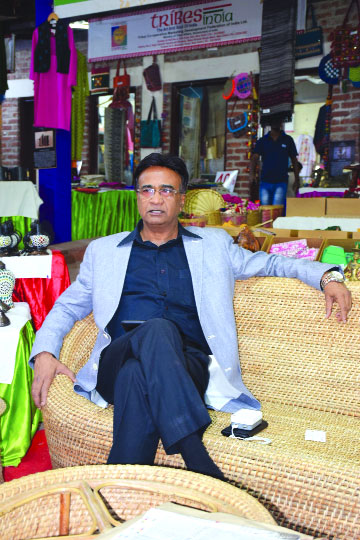Aadi Mahotsav is being from November 16-30 in Delhi and it is the perfect platform for artisans and cultural performers. The Managing Director of the Tribal Cooperative Marketing Development Federation of India (TRIFED), PRAVIR KRISHNA, in an interview with Ankita Saxena reveals the organisation’s plan to further their revenue potential
TRIFED, an organisation of the Ministry of Tribal Affairs, hosts the ‘Aadi Mahotsav’ to provide an opportunity to the families of the tribal communities to display their products to a wider audience and increase their incomes. Pravir Krishna talks about the overwhelming response to this fair and how it is helping the tribes of India live a better life through this initiative. Excerpts from the interview:
How has the response been to Aadi Mahotsav?
The fair has become bigger in scale from last year and is much brighter and better. This year, there are around 1,000 tribal artisans from 27 states of India who are showcasing their skills, cuisine, culture, music and dances. It is the perfect way to showcase the tribal ethos and has already attracted around 80,000 people till now. There are over 250 stalls and the participants have already done business worth over Rs 1 crore. We plan to organise around 200 such festivals all over the country in the coming time.
What is the objective of this fair?
The aim of Aadi Mahotsava is very simple—it is to provide the tribals with market access. These communities have some of the finest craftsmen and artisans but they are weak in marketing their products. They usually get stuck in the vicious net of the middlemen who buy these products at a very low cost from them and sell it in bigger markets at higher prices, thus robbing the tribals of the fair price for their products. We have tried to bring the producers closer to the big markets through this exhibition. To encourage them, we sponsor each participant by paying for their travel, lodging and even transportation of their goods. This is an important exhibition as the organisers do not seek to make any profit out of it, rather the earnings out of the sales here, all belong to the producers.
How else does TRIFED market the tribal products?
We create opportunities for marketing of tribal products through establishing a network of TRIFED Indian retail outlets. We are on an expansion drive and have recorded a phenomenal leap from 29 retail store to 105 outlets. Our expansion has grown by 200 per cent and our procurement has grown by 375 per cent. We believe that the tribal community now needs to take the second step towards value addition to their raw materials in order to increase their incomes. We are also engaging with the ecommerce platforms and have tied up with players like Amazon, Snapdeal, Flipart and the government agency, GeM, to take the tribal products on the digital platform.
How are you working to add value to the tribal products?
We want to turn the tribal commerce on its head and this can be done by adding value to the raw materials the tribal communities procure from the forest. They are dependent on products like handlooms, artifacts made from metal, wood, bamboo and textiles, which we are promoting through retail outlets. The minor forest produce is however equally valuable and can be used to increase the incomes. For example, mahua when sold in the market, fetches a lower price than a squash made out of it, which adds around 100 per cent value to the raw product. Similarly, tamarind can be turned into a chutney or sauce to increase its worth five times and thus benefiting the community more. We want the tribal community to get at least 70-80 per cent of the total value chain instead of the current 20-30 per cent because of the middlemen. We are also in talks with the Ministry of Food Processing Industries to set up pilot projects in Maharashtra and Chhattisgarh for the same.
What is the TRIFED Van Dhan Brigade?
We feel that the opportunity of livelihood for the tribes is not to be provided to them by any gratis or support from the government. It is in fact, their right to trade as given by the Forests Rights Act and we are the vehicles to further this. The government is playing its role by identifying the tribes, training them to fine-tune their craft according to market needs, procuring the products and then distributing them. The TRIFED Van Dhan Brigade is our initiative to help the tribal communities achieve better lives. We have asked ISRO to help with satellite images to map the tribal areas. Also, in order to make this initiative successful, we have to decentralise the mechanism and use the district magistrate machinery to deliver the benefits to the right people in the remotest areas.
Writer and Courtesy: The Pioneer








 OpinionExpress.In
OpinionExpress.In















Comments (0)